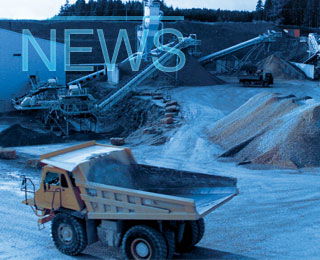Holcim increased its consolidated sales of cement fuelled by the emerging markets and North America in the 1H12. However, the group said it is advancing a cost-cutting programme as European sales drop faster than anticipated and has announced a management shake-up in an effort to streamline its group structure.
The Swiss cement major noted that first-half turnover improved 2.1 per cent to CHF10,357m (US$10,651m) and in euro terms there was a 7.6 per cent increase to €8591m. Higher sales volumes and prices as well as cost-cutting measures enabled it to increase operating EBITDA by 1.9 per cent to CHF1.9bn despite restructuring costs in markets such as Spain, Great Britain, Brazil and Mexico of CHF37m. Net attributable advanced nine per cent to CHF389m (€323m). Net debt at the end of June was 0.4 per cent lower YoY at CHF12,161m, giving a gearing of 60.9 per cent compared with 64.4 per cent last year.
Emerging markets drive performance
Overall, Holcim's cement deliveries advanced 4.4 per cent to 74Mt in the first six months with Asia-Pacific reinforcing its position as the largest source of turnover, accounting for 41 per cent of the group total. Cement deliveries in the group area rose eight per cent to 41.2Mt with the strongest volume increases being in the Philippines (+23.5 per cent) while Vietnam performed the worst with a decline of 19.9 per cent. The largest regional market of India saw volumes improve 7.9 per cent. Volumes also recovered in New Zealand but eased in Australia.
Advances in Asia contrast with negative market developments in Europe where cement shipments declined 4.1 per cent and turnover fell by 9.8 per cent to CHF2783m. Volumes were down in most markets, notably Spain (-32.2 per cent), Bulgaria (-30 per cent) and Italy (-29.9 per cent). Russia and Azerbaijan proved to be the main exceptions with volumes rising 15.1 and 40.3 per cent, respectively. The commissioning of the new line at Garadagh in Azerbaijan helped boost volumes there.
Volumes in Latin America were generally higher with the exception of Argentina. Holcim's Brazil cement volumes were 0.3 per cent ahead as capacity constraints limit production until the new kiln line at Barroso comes on-stream in 2014 adding 2.6Mta of capacity.
Improvements were also seen in North America where cement deliveries increased 8.6 per cent to 5.4Mt. Canadian cement and clinker volumes were particularly strong, registering growth of 13.5 per cent though average prices were down 1.1 per cent. US volumes advanced 8.6 per cent and prices improved by 1.5 per cent on average.
In Africa and Middle East turnover recovered by 3.3 per cent and cement deliveries improved 2.7 per cent to 4.5Mt. Morocco is the division's most important market and new clinker capacity at the Fez works should come on-stream in early February. Lebanon is a more difficult market at present and Holcim is more cautious about the outlook.
Overall, Holcim expects demand for building materials to rise in emerging markets in Asia and Latin America, as well as in Russia and Azerbaijan, in 2012. While demand in North America should beat the previous outlook, Holcim now expects a decline in Europe after previously anticipating a stable development. As such, the group said it will adopt a "cautious" approach to new investments, but still expects to achieve organic growth in operating EBITDA in 2012.
Cost-cutting focus
The group noted that its "leadership journey" remains on track, which aims to increase operating profit by at least CHF1.5bn by the end of 2014 with a target of at least CHF150m for the 2012 financial year. Going forward, Holcim said it will further cut costs and raise prices to meet financial targets. The company is most likely to increase prices for its cement, aggregates and concrete in Asia, Latin America, the US and Canada, where markets are more robust, chief financial officer Thomas Aebischer said. Question marks remain over Holcim's ability to implement prices hikes in Europe, he added.
Changes at the top
In line with new CEO Bernard Fontana's drive to improve profitability, the group has announced it is changing its management structure from the beginning of September when three of the members of the executive committee will retire and a number of responsibilities will change.
Among the adjustments, the European divisions will be bundled into one unit led by Roland Koehler, currently CEO of Holcim Group Support. Bernard Terver, head of Holcim's US businesses, will assume overall responsibility for the new group region North America and UK, and has been appointed member of the Holcim Executive Committee. Cost-cutting will be overseen by Urs Bleisch who has been appointed Corporate Functional Manager and member of senior management of Holcim Ltd. Executive Committee members Benoit-H Koch and Patrick Dolberg will leave the company. Urs Böhlen will step down from the Executive Committee and act as an advisor to the CEO of Holcim Ltd until his retirement next year.
Holcim said that the "leaner and more efficient" management structure, which will come into effect on 1 September, was designed to "strengthen the development of a new generation of leaders with broad commercial and technical experience."

Cement prices recovering in China
Cement prices in China are rebounding strongly as producers seek to improve profitability follow...